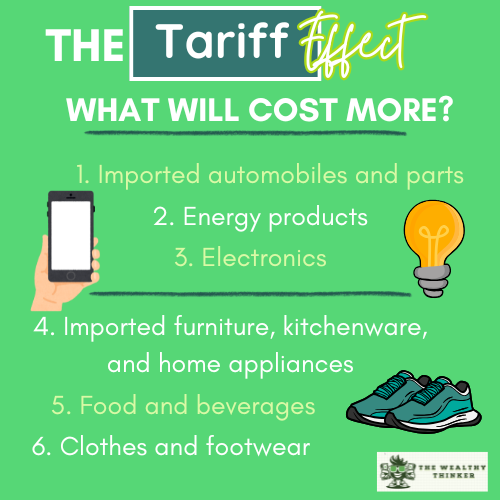You may not see it on your receipt, but the new tariffs are already showing up in your everyday purchases – from the groceries in your cart to the price tag on your next car.
While trade policies might feel distant or overly complex, their impact is very real – and very personal.
The latest wave of tariffs is raising the cost of essential goods and everyday items, putting extra pressure on household budgets that are already stretched thin.
Whether you’re upgrading your phone, shopping for clothes, or just trying to keep your house warm, chances are you’ll feel the financial ripple effects.
In this article, we break down 10 common things that are getting more expensive thanks to the new tariffs – so you can prepare, plan, and protect your wallet in the months ahead.

Top 10 Things That Will Cost You More With the New Tariffs
1. Imported Automobiles and Parts
That new car you’ve been eyeing?
It might just have gotten thousands of dollars more expensive. The 25% tariff on imported vehicles and components is expected to increase car prices by $3,000 to $6,000 per vehicle.
This hits particularly hard for popular models from Mexico, Japan, South Korea, Canada, and Germany. Even “American” cars aren’t immune – many contain significant percentages of imported parts that are now subject to tariffs.
For consumers, this means potentially extending your loan term or settling for a less equipped model to stay within budget. Used car prices may also rise as buyers seek alternatives to new vehicles.
Owning Your Car: What’s the True Cost You Should Budget for in a Year?
2. Energy Products
Just in time for seasonal changes, energy costs are set to rise.
A 10% tariff on Canadian oil, natural gas, and electricity imports is likely to translate to higher heating and electricity bills, particularly in the Northeast and Midwest regions that rely heavily on Canadian energy imports.
For the average household, this could mean paying more to keep your home comfortable year-round. Consumers may want to consider energy efficiency upgrades now to offset these potential increases.
Rising Energy Costs: 20 Ways You Can Reduce Your Heat, Water & Power Bills
3. Electronics
That new smartphone, laptop, or gaming system you’ve been saving for?
Prepare for sticker shock. Tariffs on Chinese imports have significantly increased prices for computers, smartphones, and other electronic devices.
The electronics industry relies heavily on global supply chains, with many components coming from China. Even products assembled elsewhere often contain Chinese parts, making them vulnerable to price increases.
For tech-savvy consumers, this might mean holding onto your current devices longer or considering certified refurbished options as a more affordable alternative.
4. Household Goods
Redecorating your living room or upgrading your kitchen appliances will now take a bigger bite out of your budget.
Items such as furniture, kitchenware, and home appliances imported from China are experiencing noticeable price hikes.
Many retailers absorb some of these costs initially, but as tariffs persist, more of these expenses are passed along to consumers.
Consider buying floor models, shopping seasonal sales, or exploring secondhand marketplaces if you’re furnishing on a budget during this period of inflated prices.
5. Food and Beverages
Even your grocery bill isn’t immune.
Tariffs on Mexican and Canadian imports have raised prices for products like avocados, tomatoes, and certain alcoholic beverages.
While the price of a single avocado might only increase by cents, these small increases add up across your entire grocery cart. Seasonal fluctuations in produce prices are also becoming more pronounced.
Budget-conscious shoppers might want to focus more on locally grown seasonal produce and be flexible with meal planning based on what’s most affordable each week.
Budget Meal Planning: 7 Days of Diverse & Delicious Meals for About $50 | Budget-Friendly Recipes
6. Steel and Aluminum Products
Building or renovating? Brace yourself for higher costs.
The 25% tariff on steel and aluminum imports affects construction materials, tools, and other metal goods, leading to increased costs in construction and manufacturing.
This doesn’t just impact contractors – consumers see these increases reflected in everything from new home prices to simple hardware store purchases like tools and nails.
For homeowners planning renovation projects, getting multiple quotes and considering phased approaches to spread costs over time might help manage these increases.
7. Apparel and Footwear
Your wardrobe updates are getting pricier too.
Clothing and shoes imported from China are subject to tariffs, resulting in higher retail prices across many popular brands.
The apparel industry relies heavily on global supply chains, with many major brands manufacturing in China. Even as some companies shift production to other countries, restructuring supply chains takes time and often incurs costs that get passed to consumers.
Shopping off-season sales and considering quality secondhand options might help offset these increases while brands adjust their supply strategies.
8. Cosmetics
Beauty routines are becoming more expensive as well.
Beauty products from China are experiencing price increases due to tariffs, affecting everything from makeup to skincare.
Many beauty brands source ingredients or packaging from China, even if final assembly happens elsewhere. These interconnected supply chains mean even your favorite domestic brands might be raising prices.
For beauty enthusiasts, this might be a good time to simplify routines, focus on multipurpose products, or explore more affordable dupes for high-end products.
9. Medical Supplies
Perhaps most concerning is the impact on healthcare costs.
Tariffs on Chinese imports have raised costs for medical equipment and supplies, potentially impacting healthcare expenses for both providers and patients.
China is a major manufacturer of various medical supplies, from bandages to sophisticated equipment. These increased costs may eventually be reflected in medical bills and insurance premiums.
Consumers with upcoming elective procedures might want to discuss pricing and payment options proactively with healthcare providers.
10. Agricultural Products
Finally, some food staples could see price increases due to complex trade dynamics.
Retaliatory tariffs from China have affected U.S. exports like pork and soybeans, disrupting normal market flows and potentially leading to higher domestic prices for these goods.
When export markets shrink, some agricultural products initially become cheaper domestically, but as farmers adjust production, prices often rise over time.
Consumers may want to monitor prices on meat products and consider stocking up during sales or exploring alternative protein sources if costs continue to climb.
How the New Tariffs Will Cost Us: The Bottom Line
Tariffs create complex economic ripple effects that eventually reach consumer wallets.
While some price increases may be temporary as supply chains adjust, others could persist for a longer time.
Being an informed consumer is your best defense. Compare prices carefully, consider timing for major purchases, and look for opportunities to buy when tariffs are reduced or eliminated.
Remember that these economic policies affect different regions and products in varying ways – staying aware of specific impacts in your area can help you make smarter spending decisions during this period of trade uncertainty.















